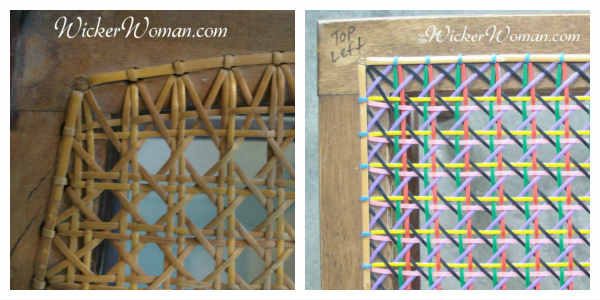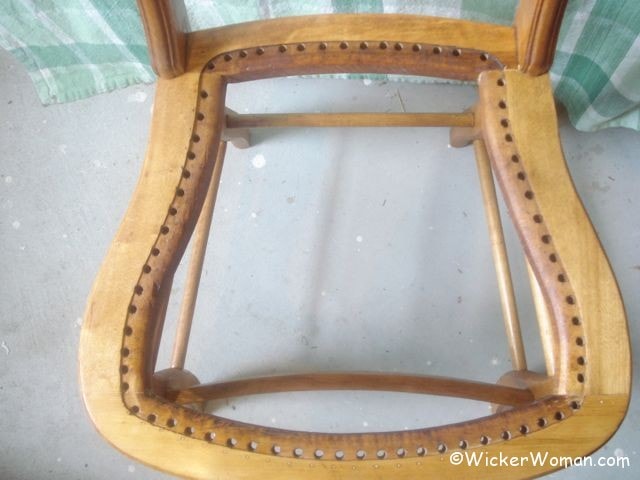
The previous weaver of this cane seat made a lot of mistakes, but for this blog post, we are only talking about one big, glaring error. We’ll use this photo to discuss other caning errors in future blog posts.
Can you spot the error that I’m focusing on here? There’s something missing in the corner-hole weaving pattern. I’ll give you a hint, it has to do with the diagonals running from lower right to the upper left.
The error that the weaver made here is that he missed putting a “fish-head” in the corner hole.
As you might recall from the chair caning instructions page, each corner on a cane seat should have only the two diagonal steps (both from the same direction), going into the corner hole, nothing else.
Not putting the two diagonal strands in that corner hole throws off all the other strands that create the “Xs” on both the top and left side of the seat. Can you see that, too?
Here’s how this corner hole should be woven, complete with the “fish head” in the corner and the “Xs” on the sides.
Oh yeah, by the way, it’s called a fish head because it looks like the profile of a fish’s head, get it?

You always want to start the diagonals in the corner and have those diagonal strands be the only strands in those corner holes.
When you put only the two diagonals coming from the same direction, into the corner hole, then everything falls into place.
That fish-head in the corner sets up all the other holes to turn out perfectly, forming all the Xs down the line.
Click here to see how to apply “fish-heads” in other places on the chair seats.
Color-coded plastic cane of the steps, like in the photo below, makes it really clear, doesn’t it? Easy-peasy!

Well, how did you do on this little quiz? Bet you aced it, didn’t you?
Let me know what you think about this little but so important, frequently missed caning step.
Yeah, I know there are tons of other errors here, but we’ll address all those in future blog posts.
Stay tuned and thanks for hangin’ out with me. If you liked this post, please share it with your peeps!

What are your thoughts about this blog post?
Leave your comments below and share with your social networks!
~~Live Well, Laugh Often, Love Much ~~
Happy Weaving, until next time!






Hello,
I am new to caning and have a dining room chair seat bottom I want to repair. When I removed the old busted cane, I discovered it had a double-layer caned seat. I cannot find information on the internet related to this type of caning. Can you point me in the right direction, is this something I can replicate? Does it need a double-layer seat bottom?
Thanks Lesa
Hi Lesa,
Did you by any chance see the article I wrote about determining what kind of woven seat you have? Perhaps what you have is a “porch cane” or a “wide binding cane seat”. Does the pattern wrap around the rungs and appear both on the top and bottom of the chair seat? Or does yours seem to be something else?
Hopefully, this article will help you figure out what you have and what type of materials to use with the appropriate weaving technique. Please look through all the Weaving Basics #101 articles under the Resources tab at the top of every page. Also, check out the How-to Videos as well as the Seatweaving FAQ page.
Happy to hear you are joining the ranks of the chair seat weaving nerds! I’m adding a few online weaving classes in the real near future so stay tuned!
I don’t think you are answering questions any more but it does not hurt to ask. I have just started caning (did 2 chairs) and love your site. I have a beautiful chair but two of the holes on each side of the front are blocked by the leg. This is each of the front corner holes and the one above it. I saw some pictures where is looked like someone put a plug in the corner to hold the cane and binding cane. Is this a possible solution?
I have a chair that has 10 holes per 6 inches in the back and 9 holes per 6 inches in the front and sides. To get the correct cane do I use the back measurements?
I’m having a terrible time with the cane splitting/breaking even after soaking. Can the caning be too old?
Hi Barb,
So sorry to hear about your mishaps with the splitting cane. Sometimes it means that the cane is too old and brittle and then again sometimes you just get a bad batch.
How old is the cane and how were you storing it? And when did you buy it? If you contact your supplier, it’s possible that they might exchange the coil for you.
But ever since the embargo that the President of Indonesia set in 2012, the quality of cane has gone down considerably.
Here’s a video that I made about using split cane, so if your coil is not too bad, maybe you can use it anyway?
Visit the How-to Videos page for more hints and tips on chair caning and other types of chair seat weaving. Enjoy!
A friend of mine saw a photo of a couple of chairs I caned and she was excited and asked if I would be interested in re-caning an antique piano bench. I said yes, but upon inspection noticed that the cane is actually glued to a half-round strip of wood (about 1/4″ wide) and the strip is glued to a recessed channel around the opening of the seat. I have photos of the bench and close-ups of the cane attached to the seat, and if you would be willing I will e-mail them to you (to make a long story shorter). I need to know if there is a product I can apply to dissolve the glue without harming the surrounding wood. Thank you!
Hi there Elizabeth,
What you are talking about there with the piano bench is the very simple cane webbing, or sheet cane or spline cane removal and replacement. The webbing and the reed spline are held in with glue that most weavers know to use only white glue or hide glue, which are both easy to remove.
All you need to do is to follow my directions on this page How-to Easily Remove Cane Webbing to get three ways to remove the reed spline from the groove! Also on this page is a link to directions on How-to Easily Install Cane Webbing.
Be sure to check out all the hints, tips, and suggestions on the Articles tab at the top of every page, too. Take your time and look through all the blog posts as well as all the other informative pages of my website.
Happy Weaving! Glad to have been of help!
I haven’t caned for 20 or so years and there is a big market for this work where I live. I don’t know what to charge if I do decide to start caning again. Can you give me an idea. The last time I caned a chair for 50 cents a hole. I am sure it has gone up as have supplies.
Hi Sharron,
Thanks for visiting my site and commenting on the blog, nice to hear you are getting back into the swing of things! What state are you in because your location does make a difference with what the market will bear in your area. When I first started seatweaving in 1975, I was charging 10 cents a hole so I know what you are talking about.
Although I’ve pretty much retired from the day-to-day repairs, you can go to my Pricing-Charges page to see what I was charging for seatweaving and wicker repair, but keep in mind those prices were what I charged in 2013. And I live in the mid-west where prices are not as high as they are elsewhere.
Then too, you can do a search on my Chair Caning Forum and you’ll come up with quite a bit of information about what others charge from all over the country.
Hope this helps and hope to see you listed on the Furniture Repair Directory™ soon, too! Go here to advertise your business effectively and at a very reasonable price! Advertise on Furniture Repair Directory™
hello again,
I am starting a crib about 15×30 area to be caned. This crib hasn’t any corner holes. How do I handle this situation? also, I am assuming it’s best to have step one be the shorter distance in a rectangle.
Hi Edie,
Since I don’t really know what you are dealing with here, there are a couple options you could use with the missing hole on the baby crib. If there’s enough room and the corner is not blocked by a leg, you could drill a hole at each corner. But if there’s not enough room, you could treat each of the other holes on either side as if they were the corner holes. Looks a bit odd when finished, but serves the same purpose. Good luck, hope this helps!
Thank you for all your info
You are most welcome Edie, glad my site helped you! Is there anything you’d like me to talk more in depth about?
How long is the recommended time to soak the strand cane? And is it advisable to use glycerin to keep the cane wetter?
Hi Colleen,
Thanks for leaving your comment, perhaps others have the same questions.
As I recommend on my Chair Caning Instructions page, cane soaking time is usually only about 5-10 minutes. But it also depends on the width of the cane, for example, if you are weaving with 6MM wide binding cane, since it’s thick, you can soak for a bit longer so it gets more supple.
For me, soaking the cane in glycerine seemed to make no difference in the cane, so I don’t need the added expense. But try it yourself, maybe you will really like the way the glycerine works and think it’s of benefit. It’s a personal decision, entirely up to you.